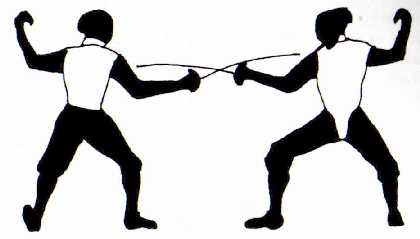
The foil evolved in the mid sixteenth century as the practice weapon for the larger and heavier rapier. From this period onward, the cutting action in sword fighting was rapidly becoming obsolete as fighters preferring the faster thrusting action of pointed weapons. Accordingly a flat edged training weapon was no longer required. And so the modern fencing foil was born, the name comes from the french refouler, meaning to turn back. In England the new training weapon was known as a foil, which was the term employed for any rebated or guarded weapon.
The original foil was shorter than its modern counterpart. But in reality there was no standard specification for training weapons and they usually differed from salle to salle depending on the taste of the fencing master. The famous french master Liancour advocated the use of many different types of foil, each designed to develop the pupils sword-play in different areas for example heavy guard-less weapons which were shorter than that of the master, thus forcing the pupil to move extremely fast if the were to be able to make a hit. Liancour's heavy foils occasioned the muscles in the sword arm of his pupils to exquisite agony, but it must be considered that for Liancour, as for his predecessors Capa Ferro, Thibault and all the great fencing masters, sword-play had a practical application. Therefore the philosophy behind Liancour's teaching plan was to enable his students to manipulate the heavier rapiers and court swords that were commonplace in a gentlemen's attire at the time.
For this reason also the target area at foil is limited to the trunk of the body. The rationale for this is once again completely logical when it is considered that fencing masters right up to the late nineteen century where instructing pupils the art of fencing, to be applied to fighting duels. It was the aim of the master to pass on skills to his pupil, to enable the latter to defend themselves adequately. An indirect consequence of this was that the instructors then established a reputation for themselves as being great masters of fencing, according who's pupils won the most duels. In order to ensure that new pupils would be able to return for classes, and not rush out after a few lessons and be killed in affair of honour the target area was limited during instruction. Masters urged their new pupils to disregard the arms and legs of their opponent, which if they were to hit may not incapacitate the opponent sufficiency to prevent them from killing the pupil. So that is why we regard only the trunk of the body, where the vital organs are located, as the valid target area for foil.
The foil has been the dominant factor in the development of modern fencing. The concept is slightly altered for the other two weapons, but the basic principles or sword-play are those learned at foil which can be used as the solid base for both epee and sabre play. The foil has dominated the fencing salle as the only acceptable weapon for many fencing masters, with sabre not being widely practiced outside the armed services, the fluret or foil reigned supreme, elegant, formal, precise and of course deadly.
